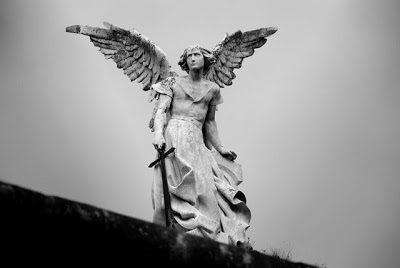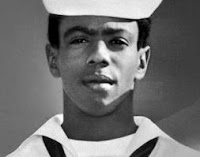 |
| “Exterminating angel” overlooking a Gothic cemetery in Comillas, Cantabria. Image from Nitehawk Hatched. |
Exterminating angels
If Dorner had been standing on a skyscraper ledge or holding Rupert Murdoch hostage, the world might have paid more attention to the injustices that he chronicles.
By Mike Davis | The Rag Blog | February 15, 2013
Racism, as readers of Richard Wright and Chester Himes know, sometimes drives its victims homicidally mad as in the cases of Bigger Thomas in Native Son or the anonymous sniper in Himes’ extraordinary short story “Prediction.”
But then again, “mad” may be a cowardly liberal euphemism for a radical defiance that would rather kill and die than submit to further lies and humiliation. Both stories are so unsettling because they leave the reader to divide unendurable injustice by the horror of its redress and then ponder the terrifying quotient.
Christopher Dorner’s Facebook “Manifesto,” the product we’re told of the acute depression that descended on the author after his dismissal from the LAPD, veers between bipolar extremes. In one section, Dorner taunts his former comrades in sneering acronyms that boast his expertise: “Your APC is defunct… My POA is always POI.”
But the rant is followed by sentimental acknowledgements to friends and several pages of fan notes to eclectic heroes who include Hilary Clinton (his first choice for president in 2016), Chris Christie (his second choice), Dave Brubeck, General Petraeus, and Ellen DeGeneres. He also passionately advocates (and provides an argument for) gun control.
Perhaps his brain synapses were misfiring for a long time, but the core of Dorner’s Manifesto is a coherent account of how a police Explorer Scout realized his life’s dream as a LAPD rookie and then had his reputation and career destroyed for being an honest cop. He debunks the myth — propagated by the Times, Los Angeles Mayor Villaraigosa, and most of the city’s liberal establishment — that thanks to Saint William Bratton (its former chief) a kinder, gentler, and more diverse LAPD now protects and serves Los Angeles.
Indeed Dorner’s eyewitness account of routine sadism, racism, and conspiracy in the department is totally in line with its historical institutional culture and was inadvertently fact-checked by the LAPD’s wild shooting of two innocent women and Chief Beck’s knee-jerk exculpation of the officers involved. (Those who think that there are no more Rodney Kings should look carefully at the case of the LAPD cop who killed a mentally-ill woman last summer by stomping on her genitals.)
If Dorner had been standing on a skyscraper ledge or holding Rupert Murdoch hostage, the world might have paid more attention to the injustices that he chronicles. But he chose instead to make his enemies’ homes his “war space” and their families his targets. Thus his spree began — not with his Barrett ’50 aimed at LAPD headquarters — but with the chilling murder of a cop’s adult daughter and her fiancée.
Outlaw heroes are not this pitiless and there is no warrior honor in killing helpless family members. So who was Dorner? He will undoubtedly be buried in multiple coffins by competing theories and explanations. Some will fit him for serial killer lunatic, while on the AM dial he’ll be denounced as liberalism’s Timothy MacVeigh. Obama will be blamed.
But I’m haunted by an eerie precedent to Dorner’s story: the legend of Mark Essex.
Essex was a monster in the same mould as Dorner: his rage at injustice and humiliation grew into annihilating violence. A young Black Navy veteran who, unlike Dorner, had almost no formal weapons training, Essex boldly attacked the headquarters of the New Orleans Police Department on New Years Eve, 1972. After killing a Black police cadet and wounding a white lieutenant, Essex escaped to a nearby warehouse where he ambushed a K-9 unit and killed another cop.
For a week he eluded a vast manhunt before suddenly reappearing in the Downtown Howard Johnson Hotel across the street from City Hall. Going floor to floor, always warning the housekeepers to flee, he shot down hotel managers and white guests, setting rooms afire as he climbed toward the roof.
The New Orleans police rushed the hotel, but Essex with uncanny accuracy shot cops off fire ladders, mowed them down in stairwells and killed them as they stepped out of elevators or got out of their cars in the streets below.
By nightfall on 7 January 1973, Essex — now bunkered on the roof of Howard Johnson — had militarily defeated the entire New Orleans Police Department. He had shot 10 police officers (killing five, including a deputy chief) and 11 white civilians (killing four) while withstanding thousands of rounds of police fire without a wound.
Ultimately a Marine helicopter was brought in and after taking numerous hits from Essex in three runs at the hotel, a police sharpshooter finally killed the one-man Black liberation army. When the coroner received what remained of Essex he counted 200 bullet wounds.
Throughout his lonely combat Essex was probably inspired by the example of a spiritual grandfather, Robert Charles. In 1900, the capstone year of Jim Crow legislation in Louisiana, Charles had been attacked by a New Orleans cop, whom he wounded in self-defense. A proud Black nationalist and supporter of return to Africa, Charles refused to turn himself over to a lynch mob.
In four days of gun battles with an army of 1,000 police and even larger groups of white vigilantes, he shot 27 whites, including 16 police, before being killed as he emerged from his burning hiding place. Ida B. Wells, the pioneer African-American journalist and anti-lynching activist, wrote a brave account of Charles’ martyrdom. (Mob Rule in New Orleans: Robert Charles and his Fight to the Death [1900] available at Project Gutenberg.)
 |
| Mark Essex. |
Essex’s Armageddon was the subject of Peter Hernon’s superb A Terrible Thunder: The Story of the New Orleans Sniper, first published in 1978, but still in print. Indeed Hernon anticipates some of the key questions that may confront Dorner’s biographer. Essex grew up in Emporia, Kansas, the child of a blue-collar Black family in an otherwise almost all white town. (Dorner emphasizes that he was the only Black child in his classes until middle school.)
Hernon finds nothing traumatic or disturbed in Essex’s life until he joins the Navy in the late 1960s and trains in San Diego as a dental technician with the hope of someday going to dental school. The white Navy dentist whom Essex assisted recalls him rather fondly to Hernon as a cheerful 19-year-old from Kansas.
But the Navy in 1969 was anything but cheerful. In the white ranks there was seething hostility against promotion of Blacks and race riots had erupted on the flight decks of the big carriers. Many Black sailors, as well as a minority of whites, are alienated by the War in Vietnam and the Nixon backlash at home.
Essex was stationed at a small naval base in Imperial Beach (last exit before Tijuana and the site of the hugely subversive and accordingly short-lived HBO series, John from Cincinnati) where he and other Blacks were constantly taunted by racist CPOs. (Hernon quotes one as loudly proclaiming “God, it must have been beautiful 20 or 30 years ago. When a nigger went to sea it was below the decks, in the galley.”) Finally after one slur too many, Essex decked a white sailor.
He was doomed. Like Bob Jones, the Black shipyard worker, in Chester Himes’ ferocious 1945 novel If He Hollers Let Him Go, a single misstep and his life spiraled downward. In face of unfair punishments and continuing abuse, Essex lost faith in a naval career. After going AWOL he was kicked out of the service. Unlike Dorner however, Essex was able to place injustice in a political framework; there are plenty of radical cats in the Navy in 1970 and he ultimately gravitated toward the Black Panthers, first in New York and then in New Orleans.
Police attacks on the Desire projects and the killing of local activists convinced Essex that it was time for war. Hernon is very clear, however, that this was a solo project, “revolutionary suicide” in the terminology of the time. But Essex didn’t die entirely alone. As he killed cops from the rooftop of the Howard Johnson, young Black people in the street cheered him.
If few actually cheered Dorner, public sympathy with his grievances has stunned the LAPD and its supporters. Over the last week, Police Chief Charlie Beck and Mayor Villaraigosa repeatedly went to the podium to remind viewers that Dorner was the bad guy not the hero. Mysterious posters appeared with Dorner’s photo and the word: HOPE. The blogosphere is crowded with personal testimonies about police brutality and the fraud of LAPD reform.
Dorner, however horrible his method, reopened the debate. He was Rodney King in body armor.
In the last hours of his life, he declined the opportunity to take a hostage, telling a white guy in a pick-up truck to simply take his dog and walk away. A few minutes later he shot two San Bernardino County sheriffs. Then like “Mad Dog” Roy Earle, played by Humphrey Bogart in Raoul Walsh’s High Sierra (1941), he hunkered down to die.
The San Bernardino SWAT Team ultimately chose to “burn the motherfucker” by lobbying pyrotechnic military CS gas canisters into the cabin where Dorner was making his last stand. The resulting inferno resurrected dark memories of the LAPD’s incineration of six members of the Symbionese Liberation Army in South Central L.A. in 1975 and the FBI’s auto de fe of Branch Dravidians at Waco in 1993. (CS grenades — notorious fire starters — were used in both cases.)
Disturbing new precedents have also been set. The use of heat-imaging reconnaissance drones to hunt for Dorner — who was repeatedly categorized as a “domestic terrorist” (eve, in one blog, a homegrown “Bin Laden”) — opens the way to Predators, Hellfire missiles, and domestic kill lists. The attempted murder of three innocent civilians (two women and a white guy) by the LAPD and the Torrance police prefigures the likely “collateral damage” that will be tolerated in future American Afghanistans.
In any event, Christopher Dorner’s ghost will be around for a very long time.
[Mike Davis is a Distinguished Professor in the Department of Creative Writing at the University of California, Riverside. An urban theorist, historian, and social activist, Davis is the author of City of Quartz: Excavating the Future in Los Angeles and In Praise of Barbarians: Essays against Empire. Read more articles by Mike Davis on The Rag Blog.]


















Great article and photo to matcht
Glad you brought this all up. The experts who called Dorner “another Jeffrey Dahmer” on local tv missed the point entirely. If his method of redress was appalling, he aroused a lot of prevailing distrust of the LAPD that crosses racial lines.
Its a pretty safe assumption that the burned him up because he knew too much about LAPD.